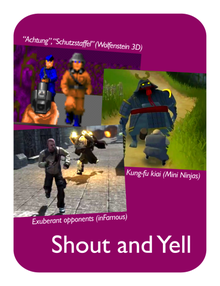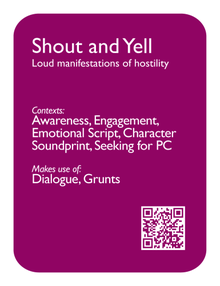Difference between revisions of "Shout and Yell"
From SoundInGames.com - Sound Design in Games
ValterAlves (Talk | contribs) m |
ValterAlves (Talk | contribs) m |
||
| Line 21: | Line 21: | ||
| revisions =Introduced in version 1.0<br />Version 2.0: updated synopsis | | revisions =Introduced in version 1.0<br />Version 2.0: updated synopsis | ||
| description = | | description = | ||
| − | [[Shout and Yell]] refers to loud expressions, either [[Grunts]] or [[Dialogue]]-like, | + | [[Shout and Yell]] refers to loud expressions, either [[Grunts]] or [[Dialogue]]-like, which a character emits with the evident purpose of messaging an hostile attitude towards others (usually NPC towards the PC, but not necessarily). |
A particular (an much less common) exploration of [[Shout and Yell]] is when it is integrated in the gameplay in association with the [[Sound Input]]. | A particular (an much less common) exploration of [[Shout and Yell]] is when it is integrated in the gameplay in association with the [[Sound Input]]. | ||
Revision as of 23:04, 24 May 2012

|

| |
| The card's front face | The card's back face |
Contents
Synopsis
| Loud manifestations of hostility. |
Relationships
Contexts:
Awareness ![]() , Engagement
, Engagement ![]() , Emotional Script
, Emotional Script ![]() , Character Soundprint
, Character Soundprint ![]() , Seeking for PC
, Seeking for PC ![]() .
.
Makes use of:
Dialogue ![]() , Grunts
, Grunts ![]() .
.
Description
Shout and Yell refers to loud expressions, either Grunts or Dialogue-like, which a character emits with the evident purpose of messaging an hostile attitude towards others (usually NPC towards the PC, but not necessarily).
A particular (an much less common) exploration of Shout and Yell is when it is integrated in the gameplay in association with the Sound Input.
Examples
  Wolfenstein 3-D: The use of Shout and Yell in this game is emblematic. It is this game's most well known Signature.
|









